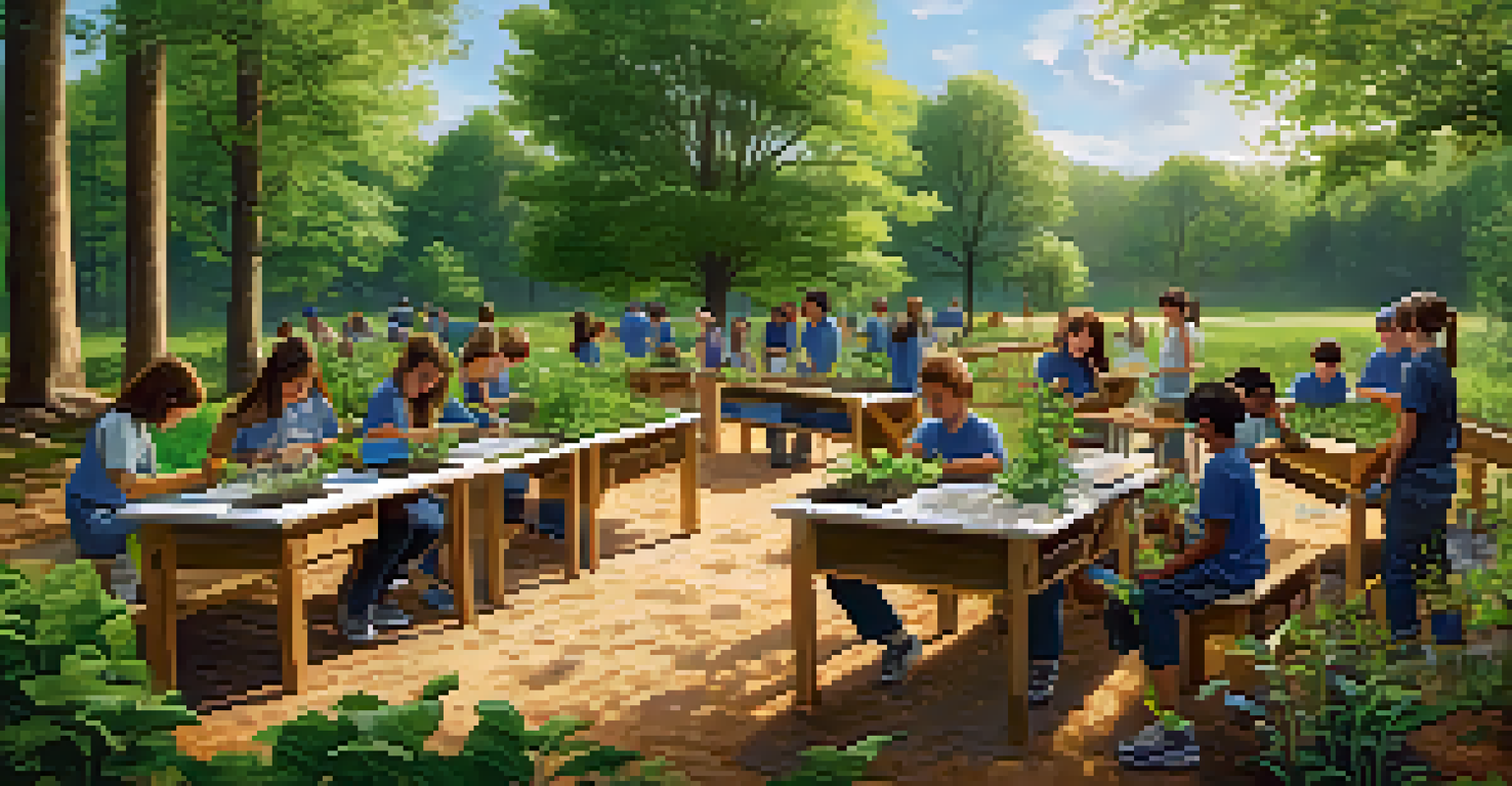Using Collaborative Learning to Promote Environmental Awareness

Understanding Collaborative Learning and Its Benefits
Collaborative learning is an educational approach that encourages students to work together towards a common goal. This method not only enhances knowledge retention but also fosters critical thinking and problem-solving skills. By engaging in group activities, learners can share diverse perspectives, making the learning experience richer and more meaningful.
Education is not the filling of a pail, but the lighting of a fire.
In the context of environmental awareness, collaborative learning can be particularly powerful. When students collaborate, they can tackle complex environmental issues, like climate change or biodiversity loss, from multiple angles. This collective effort helps to build a deeper understanding of these challenges and the importance of sustainability.
Moreover, working together empowers students to take ownership of their learning. They become active participants rather than passive recipients of information, which can lead to increased motivation and a lasting commitment to environmental issues. This transformation is essential for cultivating future generations of environmentally conscious citizens.
Creating a Collaborative Learning Environment
To effectively promote environmental awareness through collaborative learning, it's crucial to create an environment that encourages teamwork. This can be achieved by arranging students into diverse groups, ensuring a mix of skills, backgrounds, and perspectives. A variety of group assignments, such as projects or discussions, can keep students engaged and invested in the process.

Tools and resources play a significant role in supporting this collaborative environment. Utilizing technology, such as online platforms and communication tools, can facilitate collaboration beyond the classroom. This flexibility allows students to share ideas, research findings, and resources, enhancing their understanding of environmental issues.
Collaborative Learning Enhances Awareness
Students working together on environmental issues fosters a deeper understanding and commitment to sustainability.
Additionally, educators should foster a culture of respect and open-mindedness. Encouraging students to listen to each other's viewpoints and challenge assumptions can lead to richer discussions and deeper insights into environmental challenges. By prioritizing respect, students can build trust and strengthen their collaborative efforts.
Incorporating Real-World Environmental Issues
One effective way to engage students in collaborative learning is by incorporating real-world environmental issues. This approach not only makes learning relevant but also encourages students to apply their knowledge to solve actual problems. For instance, students could investigate local pollution sources or explore conservation efforts in their community.
We do not inherit the earth from our ancestors; we borrow it from our children.
By focusing on real-world issues, students can see the tangible impact of their learning. They may be motivated to take action by developing initiatives that address these challenges. This hands-on experience not only reinforces their understanding but also cultivates a sense of responsibility towards the environment.
Moreover, collaborating on real-world projects allows students to connect with local organizations or experts. This exposure can enhance their learning and provide networking opportunities that may inspire future careers in environmental fields. Ultimately, these experiences help students understand the collective effort required to tackle environmental challenges.
Fostering Critical Thinking Through Group Discussions
Group discussions are an essential component of collaborative learning. They provide a platform for students to articulate their thoughts, challenge each other's ideas, and engage in critical thinking. When discussing environmental topics, students can explore various perspectives, which deepens their understanding and encourages creative problem-solving.
During these discussions, it's important to guide students in framing their arguments with evidence. Encouraging them to back up their opinions with research or data fosters a habit of inquiry and reinforces the importance of informed decision-making. This skill is crucial for addressing complex environmental issues, where assumptions can lead to ineffective solutions.
Real-World Projects Boost Engagement
Incorporating real-world environmental challenges into collaborative projects helps students see the practical impact of their learning.
Additionally, group discussions can help students build confidence in their communication skills. As they share their thoughts and listen to others, they learn to navigate differing opinions and communicate their ideas effectively. These interpersonal skills are valuable not just in academics but also in their future careers and community involvement.
Engaging with the Community Through Collaborative Projects
Community engagement is a fantastic way to enhance collaborative learning while promoting environmental awareness. By partnering with local organizations, students can work on projects that benefit both their education and the community. This collaboration can lead to initiatives such as clean-up drives, tree-planting events, or awareness campaigns.
These community-based projects allow students to apply their learning in a real-world context, reinforcing the lessons they've learned in the classroom. They get the chance to see the positive impact of their efforts firsthand, which can be incredibly motivating. As they witness the tangible results of their work, their commitment to environmental issues can grow stronger.
Furthermore, engaging with the community fosters a sense of connection and responsibility. Students learn that they are part of a larger ecosystem and that their actions can contribute to environmental stewardship. This understanding is vital in shaping informed and active citizens who are dedicated to protecting the planet.
Utilizing Technology to Enhance Collaborative Learning
In today's digital age, technology plays a pivotal role in enhancing collaborative learning experiences. Online tools and platforms can facilitate communication, project management, and resource sharing among students. For example, using collaborative software like Google Docs enables students to work together seamlessly, regardless of their physical location.
Moreover, technology can access a wealth of educational resources related to environmental issues. Students can engage with interactive simulations, virtual field trips, and online forums that broaden their understanding of sustainability. This variety of resources can spark curiosity and inspire innovative solutions to environmental challenges.
Technology Supports Teamwork
Utilizing digital tools facilitates collaboration among students while enhancing their understanding of environmental topics.
However, it's essential to balance technology use with face-to-face interactions. While digital tools can enhance collaboration, personal connections are vital for building trust and effective teamwork. Striking this balance ensures that students benefit from the advantages of technology while still developing essential interpersonal skills.
Assessing the Impact of Collaborative Learning on Awareness
To gauge the effectiveness of collaborative learning in promoting environmental awareness, educators should implement assessment strategies that reflect student engagement. This can include peer evaluations, group presentations, or reflective journals where students articulate their learning experiences. These assessments provide valuable insights into their understanding of environmental issues.
Additionally, tracking students' involvement in environmental initiatives can help measure the impact of collaborative learning. For instance, monitoring participation in community projects or advocacy campaigns can illustrate how collaboration translates into action. This data can inform future teaching strategies and enhance the learning experience.

Ultimately, the goal is to cultivate a lasting commitment to environmental stewardship. By assessing not only knowledge retention but also behavioral changes, educators can evaluate the success of collaborative learning approaches. This reflective practice ensures that the focus remains on fostering a generation that is aware, engaged, and ready to tackle environmental challenges.